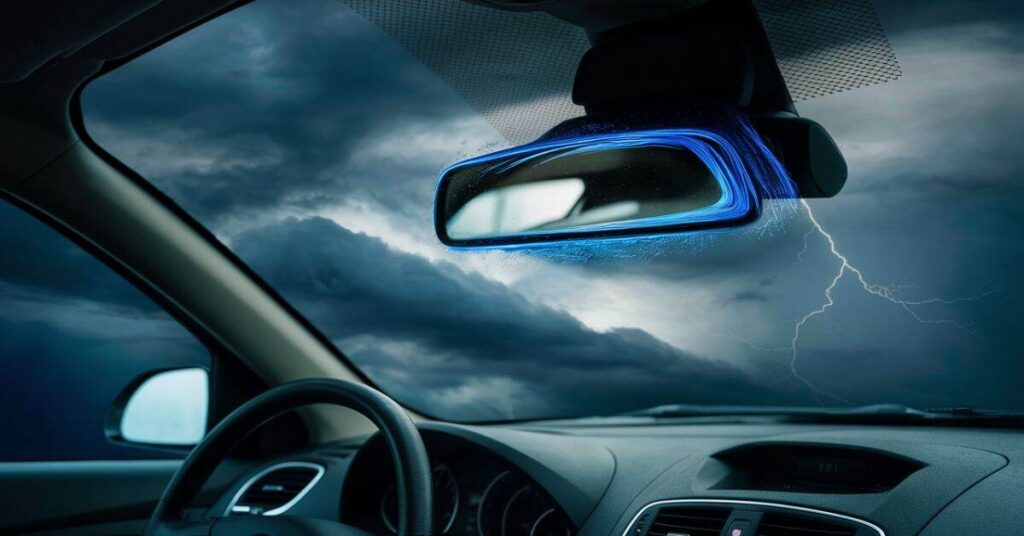Have you ever glanced at your rearview mirror while driving at night and wondered, “Why does my rearview mirror turn blue?” You’re not alone. This seemingly magical transformation is a common feature in many modern vehicles, yet it often leaves drivers puzzled. In this comprehensive guide, we’ll explore the science, benefits, and misconceptions surrounding blue rearview mirrors, providing you with all the information you need to understand this innovative automotive technology. Why Does My Rearview Mirror Turn Blue? Unveiling the Mystery Behind This Automotive Feature.
Key Takeaways
Before we dive deep into the details, let’s highlight the main points we’ll cover:
- The blue tint in rearview mirrors is a result of electrochromic technology
- This feature reduces glare from headlights, enhancing night driving safety
- Auto-dimming mirrors play a crucial role in the color-changing process
- Blue-tinted mirrors offer several benefits beyond glare reduction
- Proper maintenance can extend the life of your blue-tinted mirror
Science Behind the Blue Rearview Mirror
The blue hue you observe in your rearview mirror is no accident. It’s a sophisticated application of electrochromism, a phenomenon where materials change color or opacity when exposed to an electric field. In the case of rearview mirrors, this technology is used to create a dynamic anti-glare system.
Here’s how it works:
- The mirror contains a layer of electrochromic gel sandwiched between two pieces of glass.
- This gel is transparent in its natural state.
- When bright light hits sensors on the mirror, it triggers an electric current.
- The current causes the gel to darken, often appearing blue.
- This darkening effect reduces the intensity of light reflected to the driver’s eyes.
The blue color isn’t just for show – it’s a byproduct of the specific chemicals used in the electrochromic gel. These chemicals are chosen for their ability to effectively reduce glare while maintaining visibility.
Factors That Cause the Mirror to Turn Blue
Several factors contribute to the activation of the blue tint in your rearview mirror:
- Ambient light conditions: The mirror is most likely to turn blue during nighttime driving when the contrast between your dark surroundings and bright headlights behind you is greatest.
- Vehicle-specific technology: Different car manufacturers may use slightly different technologies, resulting in variations in the intensity and shade of blue.
- Driver-initiated controls: Some vehicles allow drivers to manually activate or deactivate the auto-dimming feature.
- Sensitivity settings: In some high-end models, the sensitivity of the auto-dimming feature can be adjusted.
- Age and condition of the mirror: Older or damaged mirrors may not function as effectively, potentially affecting the blue tinting process.
Understanding the Tinting Process of Rearview Mirrors
The tinting process in rearview mirrors is a marvel of modern automotive engineering. Let’s break down the layers typically found in an auto-dimming mirror:
| Layer | Function |
|---|---|
| Front glass | Protects internal components |
| Transparent conductor | Carries electric current |
| Electrochromic gel | Changes opacity when current is applied |
| Reflective surface | Provides the mirror effect |
| Rear glass | Adds structural support |
During manufacturing, these layers are carefully assembled to ensure optimal performance. The electrochromic gel is the star of the show, capable of changing its molecular structure when an electric current is applied, thereby altering its light absorption properties.
Benefits of Blue-Tinted Rearview Mirrors
The blue tint in your rearview mirror isn’t just a cool party trick – it offers several significant benefits:
- Reduced glare: The primary function of the blue tint is to reduce glare from headlights behind you, significantly improving visibility and reducing eye strain.
- Improved night vision: By reducing glare, your eyes can maintain better night adaptation, allowing you to see the road ahead more clearly.
- Enhanced driver comfort: Less glare means less eye fatigue during long nighttime drives.
- Increased safety: Better visibility translates directly to safer driving conditions, potentially reducing the risk of accidents.
- Automatic adjustment: Most blue-tinted mirrors adjust automatically, allowing you to focus on driving rather than manually adjusting your mirror.
“The auto-dimming mirror has been a game-changer for my night driving. I no longer dread being tailgated by cars with bright headlights.” – Sarah J., daily commuter
How to Choose the Right Tinted Rearview Mirror

If you’re in the market for a new blue-tinted rearview mirror, consider these factors:
- Compatibility: Ensure the mirror is compatible with your vehicle’s make and model.
- Features: Some mirrors offer additional features like built-in compasses or temperature displays.
- Brand reputation: Stick to reputable brands known for quality automotive products.
- Professional installation: Unless you’re confident in your DIY skills, professional installation is recommended to ensure proper functioning.
The Role of Auto-Dimming Mirrors in Color Change
Auto-dimming mirrors are at the heart of the blue-tinting phenomenon. These sophisticated devices use sensors to detect bright light from behind your vehicle. When activated, they trigger the electrochromic process that darkens the mirror.
Key components of an auto-dimming mirror system include:
- Forward-facing sensor
- Rear-facing sensor
- Control unit
- Power supply
- Electrochromic element
This system works continuously, adjusting the mirror’s tint in real time to provide optimal visibility based on current lighting conditions.
Common Misconceptions About Blue Rearview Mirrors

Let’s debunk some common myths:
- Myth: The blue tint is just for aesthetics.
Fact: The blue color is a byproduct of the glare-reduction technology, not a design choice. - Myth: Blue-tinted mirrors reduce visibility.
Fact: They improve visibility by reducing glare. - Myth: The blue tint is permanent.
Fact: The tint is dynamic and adjusts based on lighting conditions. - Myth: All rearview mirrors turn blue.
Fact: Only mirrors equipped with auto-dimming technology have this feature.
Tips for Maintaining the Blue Tint of Your Mirror
To keep your blue-tinted mirror functioning optimally:
- Clean gently with a microfiber cloth and glass cleaner
- Avoid harsh chemicals or abrasive materials
- Don’t apply excessive pressure when cleaning
- Check for any signs of damage or malfunction regularly
- If issues arise, consult a professional rather than attempting DIY repairs
Frequently Asked Questions
Can I Remove the Blue Tint From My Rearview Mirror?
Removing the blue tint isn’t recommended as it’s an integral part of the mirror’s functionality. Attempting to remove it would likely damage the mirror. If you prefer a non-tinting mirror, consider replacing the entire unit.
How Long Does the Tint on a Rearview Mirror Last?
With proper care, the auto-dimming feature should last the lifetime of the vehicle. However, extreme conditions or physical damage can affect its longevity.
Are There Any Safety Concerns With Using a Blue-Tinted Rearview Mirror?
When functioning correctly, blue-tinted mirrors enhance safety by reducing glare. However, a malfunctioning mirror could potentially compromise rear visibility, so it’s important to ensure it’s working properly.
Can the Blue Tint on a Rearview Mirror Affect My Vision While Driving at Night?
The blue tint is designed to improve night vision by reducing glare. If you find it’s negatively affecting your vision, consult with your vehicle’s manufacturer or a professional to ensure it’s functioning correctly.
Are There Any Regulations Regarding the Use of Blue-Tinted Rearview Mirrors?
In the United States, auto-dimming mirrors are generally considered safety features and are permitted. However, regulations can vary by state, so it’s worth checking local laws if you’re considering aftermarket installation.
Blue Rearview Mirror Benefits
To summarize, the key benefits of blue rearview mirrors include:
- Reduced glare from headlights
- Improved night vision
- Enhanced driver comfort
- Increased safety
- Automatic adjustment to light conditions
- Potential reduction in eye strain and fatigue
Why Does My Rear View Mirror Turn Green?
While blue is the most common tint color for auto-dimming mirrors, some drivers might notice a greenish tint. This is typically due to slight variations in the chemical composition of the electrochromic gel. The functionality remains the same, with the green tint serving the same glare-reduction purpose as the blue tint.
Auto-Dimming Rear View Mirror
Auto-dimming technology is the driving force behind the color-changing effect in rearview mirrors. These mirrors use photosensors to detect bright light from behind the vehicle, triggering the electrochromic reaction that darkens the mirror.
Pros of auto-dimming mirrors:
- Automatic adjustment to light conditions
- Reduced glare and eye strain
- Improved night driving safety
Cons of auto-dimming mirrors:
- Higher cost compared to standard mirrors
- Potential for malfunction in extreme conditions
- May require professional repair if issues arise
Why Is My Rear View Mirror Dark?
If your rearview mirror appears consistently dark, it could be due to several factors:
- Stuck in a dimmed state due to a malfunction
- Overly sensitive light sensors
- Physical damage to the mirror or its components
- Electrical issues affecting the auto-dimming feature
If your mirror remains dark, it’s best to consult with a professional to diagnose and resolve the issue.
BMW Side Mirrors Turn Blue
BMW, known for its innovative automotive technologies, has extended the auto-dimming feature to its side mirrors in some models. This provides a more comprehensive glare-reduction system, enhancing overall visibility and safety.
Case Study: BMW 7 Series
The BMW 7 Series luxury sedan features auto-dimming technology in both the rearview and side mirrors. Drivers report significantly reduced glare from all angles, leading to more comfortable and safer night driving experiences.
Rear View Mirror Glue
The adhesive used to attach rearview mirrors is crucial for safety and functionality. If your mirror becomes detached, it’s important to use the correct type of adhesive for reattachment.
Types of mirror adhesives:
- Epoxy-based adhesives
- Acrylic-based adhesives
- Polyurethane adhesives
Always follow manufacturer guidelines or consult a professional when reattaching a rearview mirror.
Auto-Dimming Side Mirror
The extension of auto-dimming technology to side mirrors represents the next step in comprehensive glare reduction. This feature is becoming increasingly common in luxury vehicles and high-end trims of mainstream models.
Future trends in auto-dimming technology:
- Integration with adaptive headlights
- Customizable dimming levels
- Incorporation of heads-up display technology
Conclusion
The blue tint in your rearview mirror is a testament to the ongoing innovation in automotive safety technology. Far from being a mere aesthetic feature, it plays a crucial role in reducing glare, improving night vision, and enhancing overall driving safety. As we’ve explored, this technology relies on sophisticated electrochromic processes and auto-dimming systems to provide real-time adjustments to changing light conditions.
Understanding why your rearview mirror turns blue not only satisfies curiosity but also helps you appreciate and properly maintain this important safety feature. As automotive technology continues to evolve, we can expect to see further refinements and expansions of this technology, potentially extending to all vehicle mirrors and even windows.



